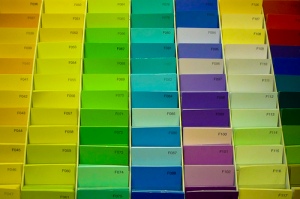Even the most eclectic collection of furniture and decor can seem unified if you establish a color palette for the room and work within that scheme.
As I mentioned in this post, when I set out to cute-ify my kitchen, one of the first steps was to decide what color scheme I wanted to use. Before I even moved into my apartment, I knew I wanted it to have a beachy and open vibe, so blue-greens were a natural choice. I painted the walls a deep sea foam and bought linens in shades of turquoise. I decided my accent colors would be a warm brown, like my paper towel holder, and green as in my kitchen rug.
That example had a pretty narrow spectrum of colors I wanted to use, but not every color in your scheme has to be next to each other on the color wheel. Here are a few tips on thinking outside the box to create a color scheme for your room.
- Start with paint chips. Head to your local hardware store and collect paint chips in a wide variety of hues and values that will allow you to mix, match, and experiment freely. Pick up paint chips that have multiple values of a pigment on one sheet, and cut the chips to separate the values and allow you more flexibility. Then arrange and rearrange them freely until you stumble upon a color combination you particularly like – working without setting yourself boundaries could bring out ideas you would never have considered otherwise!
- If it’s not an empty room, start with the objects you can’t change. Somewhat luckily for me, my apartment was completely empty when I moved in. But if you’re on a redecorating kick, start thinking about colors relative to the piece(s) of furniture that have to stay. Painting a room and buying accent pieces are much easier and less expensive than a new couch or bed.
- If you get stuck, try complimentary colors. As I said before, not every color in your scheme needs to be next to each other on the color wheel. If you want to add a little pop to a room, try jumping across the color wheel and using a complimentary color. For example, a well-placed orange accent will work great against a rich cerulean.
- Browse the fabric store and sew your own decorative items. My last post was about choosing a fabric for home decor based on texture and other factors, and deciding to DIY your home decor even simply for accent pieces will allow you more options while working within your color scheme. It’s also much less expensive than buying everything from a boutique.
- Look for inspiration wherever you find it. Don’t just browse others’ home decor for color inspiration. Color is everywhere! A picture of a parrot could be the jumping off point for a vibrantly colored room, or the local park might give you ideas for earthy, natural tones. If it inspires you, it’s not wrong!
Try these techniques and see if they don’t get the color juices flowing!







